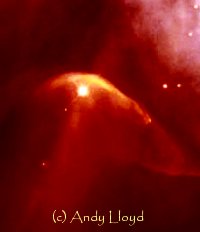
Nibiru: The Solution
For years I have puzzled over the many anomalous and often intractable problems presented by Zecharia Sitchin's Nibiru. A planet that behaves like a comet did not seem to me likely to support life forms similar, if not identical, to us. In 1999 I proposed that the only way that sufficient warmth could be generated among the comets would be if such life existed on a planet orbiting a Dark Star that was itself orbiting the Sun.

For various reasons I suggested that the Dark Star was itself Nibiru, passing directly through the planetary solar system during perihelion with its own retinue of planets. This was a bold claim, given the size of the brown dwarf required (1).
But I now realise that I was wrong, for a number of technical reasons.
I remain absolutely convinced that the Dark Star exists, and that it is a binary 'star' orbiting the Sun that approaches the planetary zone of the Sun every several thousand years. But I now believe that this Dark Star is not itself Nibiru. It is simply Nibiru's own parent 'star'.
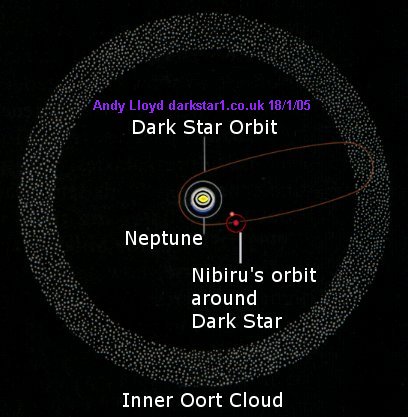
The solution I am proposing on this page brings me back towards Zecharia Sitchin's own previous work (2,3). I still add the Dark Star system to his paradigm, and I still require life to exist on a planet/moon closely orbiting that brown dwarf which I have written so much about. But neither the Dark Star nor the Homeworld are ever seen from Earth.
Their closest approach is way beyond Pluto, through the so-called Kuiper Gap, in the Edgeworth-Kuiper Belt beyond Neptune. The planet that is seen is Nibiru; the OUTERMOST planet of the Dark Star system. And apart from it being unable to maintain life, Nibiru is essentially how Sitchin describes it; a reddish terrestrial planet that brightens with a cometary aura when moving amongst our Sun's family of familiar planets.
However, Nibiru is also inextricably linked to the Dark Star and, furthermore, DOES NOT APPEAR TO ORBIT THE SUN when viewed from Earth!
This is a remarkably bizarre claim, I know. But it is part of the problem posed by Sitchin's Nibiru. Indeed, it was the primary objection levelled at me by Dr John Murray, the English academic who wrote a paper providing indirect evidence of a brown dwarf orbiting the Sun (4). He looked at the set of constellations that Nibiru passed through at perihelion and stated frankly that the body was simply not orbiting the Sun, therefore Sitchin's theory was wrong. At the time I put this down to possible misinterpretation of ancient texts. Now I realise that this anomaly was actually part of the puzzle...Sitchin's whacky orbit was right all along!
The 3-Body Solution
The solution I am proposing neatly answers a number of other problems. In fact, everything seem to fall in to place beautifully. To help me explain the rather complex issues underlying this solution, I have created some detailed diagrams, the first of which shows how Nibiru is seen to enter the planetary solar system moving backwards through the sky (the so-called 'retrograde motion of Nibiru):
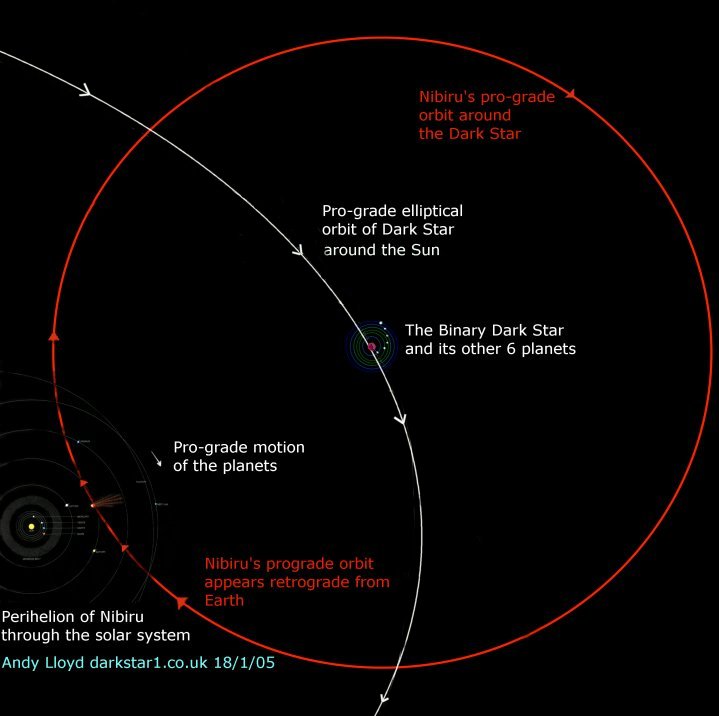
This diagram needs a little explanation. Bottom left is the planetary solar system out as far as Neptune and Pluto. In the centre of the diagram is the binary Dark Star system which moves around the Sun in a large ellipse taking thousands of years. It has reached 'perihelion' in the diagram, being at its closest point to the Sun. Nevertheless, it is still over twice the distance from the Sun as Neptune.
This distance corresponds to the Kuiper Gap, an area in the comet belt beyond Neptune that is clear of bodies. So, the Dark Star is about 70-80 Astronomical Units away from the Sun at perihelion. It is too distant to be seen from Earth.
The Dark Star orbits the Sun in a similar way to the other planets; pro-grade. I now believe that it has always orbited the Sun, having emerged from the Sun's birth cluster as a binary.
This removes the difficulty posed by a 'capture' scenario, which is statistically unlikely, although not impossible. The pro-grade orbit is also in keeping with the discovery of Sedna, which also has a pro-grade orbit. I strongly suspect that there is a relationship between the orbits of Sedna and the Dark Star; probably taking the form of a resonant orbit. Indeed, the movement of a brown dwarf through the Edgeworth-Kuiper Belt at perihelion would explain many the apparent anomalies of the bodies found in its scattered disc. It makes sense of the science.
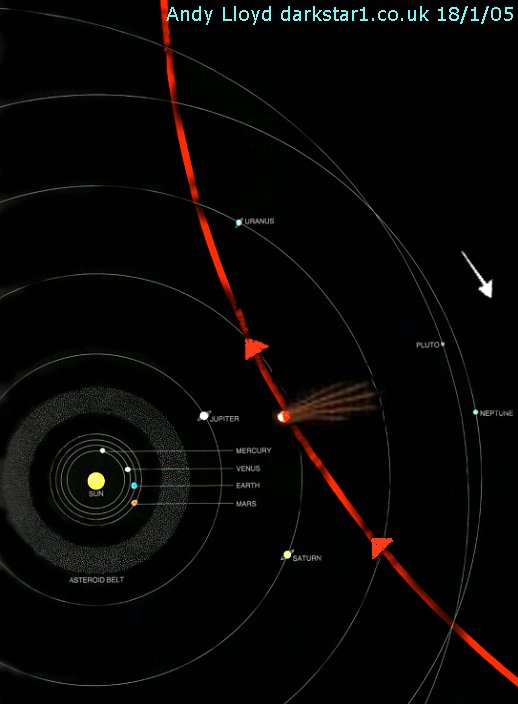
There are seven planets in the binary Dark Star system according to the myth. I suggest that one of the inner planets is a habitable world similar to Earth. It is warmed by its proximity to the brown dwarf, and is bathed in its very dim, reddish light. The planets orbit the dark star in a pro-grade movement, in keeping with the initial formation of the binary star system 4.6 billion years ago. They also orbit the Dark Star in much less time than it takes for it to transit perihelion around the Sun. Even the outermost planet shown, which is seen cutting through the outer planetary solar system, is moving faster than the Dark Star. The result is that, although the Dark Star and its outermost planet are actually moving pro-grade, from the point of view of an observer on Earth the outermost planet is seen to move retrograde across the sky. This explains a long-standing anomaly.
That outermost planet is Nibiru. It is seen from Earth as a planetary comet. I think it unlikely that it comes as close to us as the inner solar system; it would be perturbed by the Sun's gravity. But it would be visible even beyond Jupiter because of the shedding of some of its volatile surface ices; it would act as a massive comet even at a tremendous distance from the Sun.
Its perihelion distance will vary over different passages as its own orbit around the Dark Star coincides with the perihelion passage of the system as a whole (so my view here is necessarily 'ball-park'). On occasion there will be an exact juxtaposition between its own perihelion and that of the Dark Star, along a line of sight from the Sun.
Other times it will be on the other side of the Dark Star during the binary perihelion. So the timing of Nibiru will necessarily vary, as will its sky position and relative brilliance. Perhaps this is why there are so many unknowns about the transitory appearance of this body.
Another important detail is the fact that Nibiru is not seen to swing around the Sun. It seems to come towards the Sun and then quickly recedes without traversing a large portion of the sky.
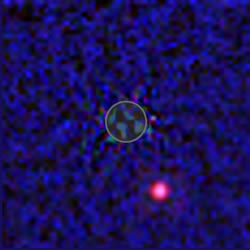
This explains the weird set of constellations moved through (which probably vary between different transits anyway), and also the short period of time that Nibiru can be seen. Even though the Dark Star may take literally hundreds of years to traverse perihelion, the time that Nibiru is observable from Earth is likely to be short; perhaps a matter of weeks or months. I suppose it's possible that there may even be more than one visible transit during a total binary perihelion. Either way, this scenario opens up a number of new possibilities.
The idea that one of the Dark Star's planets is our 'Planet X' has been suggested to me by a couple of people before, most notably Rajasun. At the time I was mildly sceptical because it seemed unlikely to me that a small brown dwarf would be able to maintain a planetary system at such a distance; I am suggesting here that Nibiru may be orbiting at about 60AU from the Dark Star (and this may vary as well if its own orbit is elliptical around the binary parent).
But a recent precedent was discovered in the form of a large planet (of about 3-10 Jupiter masses) imaged at a similar sort of distance from a free-floating brown dwarf (of about 26 Jupiter masses) known to astronomers as '2M1207'. The distance between them is approximately 40 AU (5). The Hubble image here shows the planet (in pink) near to the parent 'star' (centre) (6). So it's not difficult to extrapolate a similar situation for our binary Dark Star, with Nibiru as the accompanying planet.
The '12th' Planet
This finding has turned my thinking around. It presents us with the potential for a 3-body solution to the orbital configuration. Also, instead of one Planet X body we now essentially have 3 notables; the Dark Star and two major planets orbiting it (the other 5 appear to be minor bodies). Those two notables are Nibiru at ~60AU distance and the Homeworld much closer to the Dark Star itself. Add these bodies to the 9 known planets to the solar system brings us to 12 planets, which seems closer to the Sumerian 12th Planet scenario than Sitchin himself!

This image shows the solar system according to my binary Dark Star scenario: (from left to right) The Sun, Mercury, Venus, Earth, Mars, Jupiter, Saturn, Uranus, Neptune, Pluto, the binary Dark Star, the Homeworld, and Nibiru.
The 'Ferry'
Other aspects of the myth surrounding Nibiru become more understandable with this hypothesis. In their classic book ‘Hamlet’s Mill’, Giorgio de Santillana and Hertha von Dechen explored the mysterious nature of ‘Nibiru’ in 1969, and showed that, at that time, no scholarly theory adequately explained its celestial nature. Not much has changed since then, except Sitchin's books of course. Here's what Santillana and von Dechen had to say about what the name Nibiru actually means:
“The plain meaning of “nibiru” is “ferry, ferryman, ford” – “mikis nibiri” is the toll one has to pay for crossing the river – from eberu “to cross”." (7)
The 'Planet of the Crossing' is thus a ferry of sorts. This has made little sense up until now because the implication is that Nibiru takes travellers onto another place. That place was never defined by Sitchin who insisted that Nibiru was the homeworld of the Anunnaki itself. Yet, with our new insight the meaning behind the name 'ferry' becomes crystal clear.
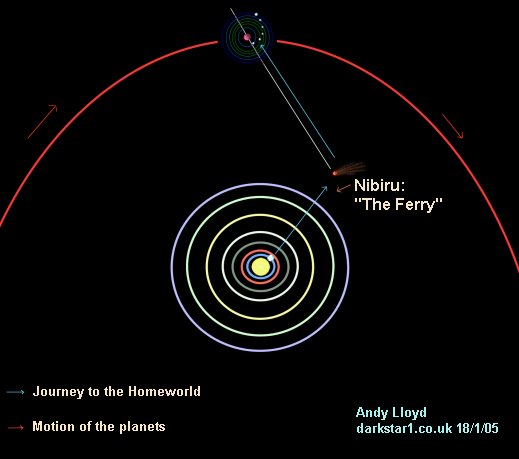
The transit of the Dark Star around the Sun at perihelion is still a very remote event. At its closest the Dark Star is still twice as far away as Pluto. To rendezvous with the Dark Star would take many years of space travel with the risk of missing an object too remote to observe.
Yet Nibiru acts as an intermediary. It swoops into the planetary Solar System and then returns to the comet clouds. It would provide space travellers with the ideal stepping stone to the Dark Star. It literally acts as a ferry. There may be other symbolic overtones to this. If the Anunnaki are physical gods, then their Homeworld is mythological Heaven. It is very similar to Earth ('as in Heaven, so on Earth', 'As Above, so Below' etc).
The myth of the Ferryman coming to collect the dead to take them to the Underworld could have new meaning in the light of this new hypothesis.
Angle to the Ecliptic
Another vexing issue with Sitchin's model is the fact that Nibiru is said to move through the heavens at a 30 degree angle to the ecliptic, nearly twice that of Pluto. Yet, a sizeable planet moving through the planetary Solar System at such an extreme angle to the plane of the other planets would cause chaos over time to their orbits. This is called the Kozai effect, which has become a huge headache for me in recent years. Again, this new hypothesis allows us to circumvent this problem in that the Dark Star does not actually move through the planetary solar system at all. However, Nibiru, its outlying planet, does, and Sitchin seems reasonably clear about its angle of inclination from the texts he has studied. How do we explain this?
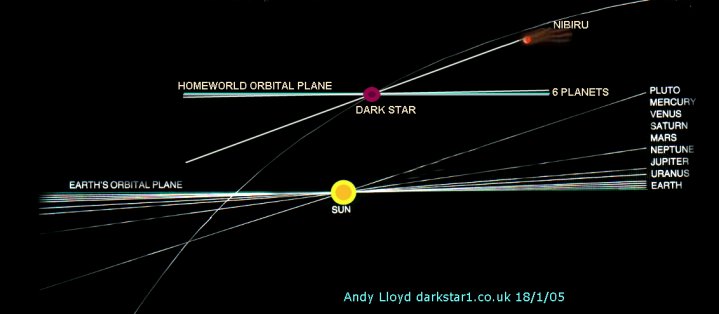
It seems likely that the inner planets of each of the binary stars (the Sun and Dark Star) should be as they were created; relatively flat to the plane of the initial proto-planetary disc. Billions of years of interaction between the peripheries of these estranged systems, however, will have lead to chaos and perturbation among some of their outer planets. In the Sun's case Pluto is clearly perturbed, as are many of the bodies recently discovered beyond it. So it seems likely that Nibiru is similarly affected, along with any of the Dark Star's own retinue of comets in its locale.
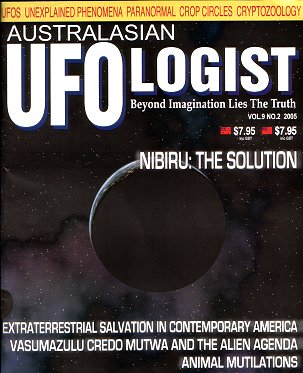
This means that Nibiru's visible arc across the sky could very well be seen to transit a relatively steep inclination, reflecting this angle to the ecliptic. Yet, the binary Dark Star may still move along a path more in keeping with the Sun's other planets. The upshot of this is that we can predict little about the Dark Star's location from the reported transit of Nibiru. This has always been my gut-feeling anyway.
I tend to think that the Dark Star lies close to the ecliptic, and still favour the area around Sagittarius as its current location (near to aphelion). This is because the actual 'line-of-sight' perihelion is the Duat region, around Sirius and Orion. Sagittarius is opposite this region on the ecliptic.
But this is only my opinion. Others differ. If my hypothesis here is correct then detailed efforts to deduce the whereabouts of the Sun's binary companion and its own system of planets are almost bound to fail. There are simply too many complicating factors at play.
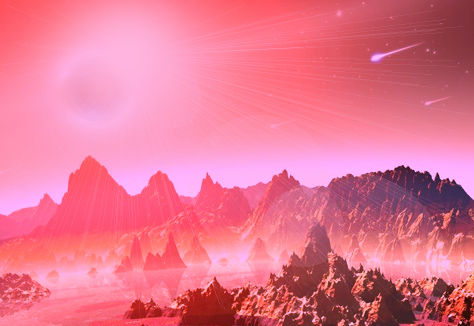
This new hypothesis is exciting and elegant. It has meant a complete re-write for me, of course, but that's the nature of progress. This is an evolving study, rather like science itself one might say. I explore this entire subject in more depth in my book "The Dark Star".
The Seven Gates between Heaven and Earth
Brant McLaughlin writes:
"I have come across something in my research that I feel can contribute to corroboration of your most recent and best-refined orbital mapping of the Nibiru System, in the mythological section of your website.
""Enlil, an Anunnaki and Enki's [brother], appears to have had a star gate of his own at E.KUR in Nippur, called the DUR.ANKI, the heaven-earth bond, which lead to the Courtyard of "An" in "heaven", who was the premiere Anunnaki. Both of these "star gates" have seven gates between Earth and their final "mentioned" destinations."
"Since the Sumerians dubbed Earth "Planet Seven", let us assume logically that there exists some form of a "star gate" stationed in orbit around each of the seven planets beginning with Pluto and proceeding inward of the solar system to Earth, which is therefore why there are seven gates in between Nibiru and Earth. Then, after travelling to or through each one of these way-station gates, one then makes the celestial leap to Nibiru/the Home World. Thus, just as you have determined, Nibiru/the Home World never truly crosses into the solar system proper."
Reproduced with permission from Brant David McLaughlin.
(This article appears in Vol.9 No.2 of Australasian Ufologist)
2022 Update:
The Dark Star's L1 Lagrangian Point
The scenario discussed above is contingent upon whether a loosely bound moon could be pulled away from the sub-brown dwarf by external gravitational forces. If the binary companion is located remotely, and is therefore not directly affect by the gravitational influence of Neptune, then it seems reasonable to suppose that it might have orbiting moons at an extended distance from itself. An issue arises should the Dark Star system make an approach to the edge of the solar system proper (e.g. approaching the outer planets). Each planet has a sphere of influence over its moons that is dependent upon its mass. This is known as the Hill Sphere.
Earth's Hill sphere extends out to about 1.5 million kilometres, or 0.01 AU. The radius of Jupiter's Hill Sphere, by comparison, is about 10 times greater, or about 0.1 AU (8). This will be similar in magnitude to a binary companion's own sphere of influence over its moons. This is considerably less than the distances I have described in this article. That's not to say that an object cannot orbit outside that limit; but that the further away it is, the more likely it will be affected by other influences which will degrade the planet's hold on that moon.
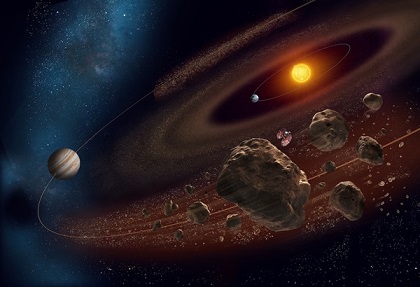
Image Credit: Roen Kelly
Essentially, if my speculation here is correct, then a loosely bound 'ferry' moon accompanying the Dark Star system could be subject to forces during perihelion which would likely break its connection with its parent system. There are other potential solutions to this. For instance, a 'ferry' might be located within the L1 'Lagrangian' point of the Dark Star's extensive eccentric orbit, where gravitational and centrifugal forces are finely balanced.
Each planet has five LaGrange points, the stability of which vary with location. L4 and L5 are relatively stable, running along the orbital path of the planet itself. In Jupiter's case, these areas are home to the Greeks and Trojans respectively. If objects accompanying the Dark Star were located at L4 or L5 then they would share the planet's orbital path (either as heralds or followers). Let's consider Jupiter's less celebrated L1 position:
"L1 is between the Sun and Jupiter, where their gravities both balance perfectly! Interestingly, L1 has a smaller orbit path than Jupiter’s, but an object in L1 has the same orbital period as Jupiter." (9)
L1 is about 0.3 AU away from Jupiter. Given that the Dark Star's own orbit is absolutely massive, the distance between this its L1 point and the binary companion would be very considerable - perhaps of the order of 30 AU for a Planet X object located 500 AU away. The Dark Star's L1 position could therefore be located ~30AU closer to the Sun, along the Dark Star/Sun axis. A loosely bound object located here might pass considerably closer to the planetary zone of the solar system than the Dark Star itself as both swing around the Sun, and thus offer a staging post for travel between the two systems.
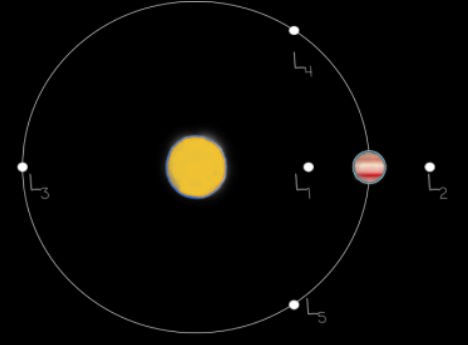
Nibiru and Marduk
Let's say 'Marduk' is the main planet, or 'Dark Star': A
significant world in a highly eccentric orbit, currently lying way out
there. Nibiru is the ferry between us. It could be a moon, some
speculate a spacecraft. I'll go with a moon. It's not a habitable,
close-set moon, but one that's on the fringe (like our Pluto). Let's
consider whether it could penetrate the Sun's planetary zone during Marduk's
perihelion passage.
Looking at the evidence - extended scattered disk objects (ETNOs) indicate
clustering due to an external body (10). That effect is presumed to be due to a
distant Planet X body that never gets very close (11). Let's argue
that that assumption is wrong - that Planet X does come much closer, rather
like a comet. If Planet X is essentially a super-comet, then it could
obviously penetrate into the inner solar system, as Sitchin envisages (2).
But if it's a significant planet doing this, then it would be disruptive to
lots of orbits, including its own, causing scattering.

This is why I consider Marduk's approach to be a less up-close and personal
one. Let's say it comes up to about 60AU at perihelion, twice the distance
of Neptune. At that distance, it could affect the orbits of the ETNOs
causing the alignments that are so suggestive of Planet Nine. But then it
could swing way out into the abyss (much further than anticipated for Planet
Nine), explaining why it's been so tough to find these last 5 years.
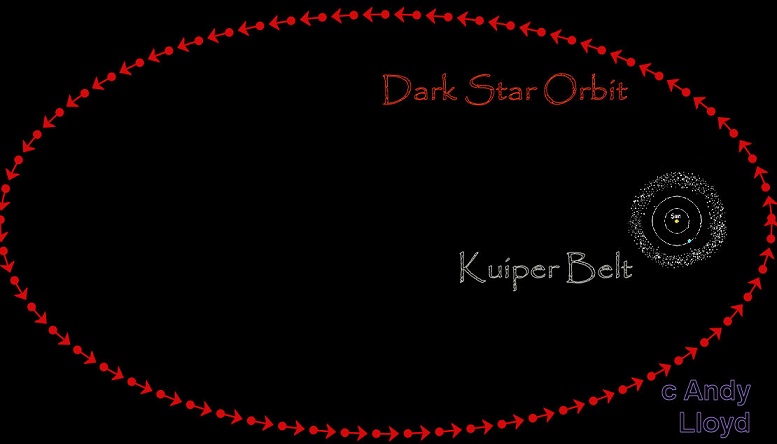
So what of the ferry, Nibiru? If that is a loosely bound object located at some distance from Marduk, then it could make a deeper incursion into the Sun's territory during Marduk's perihelion passage. In the essay above, written in 2005, I had thought Nibiru might be a classical moon orbiting at a huge distance from Marduk. However, there is a good chance it would be dislodged by the Sun or the planets during one of these incursions. Nibiru would lie too far out of Marduk's 'Hills Sphere'.
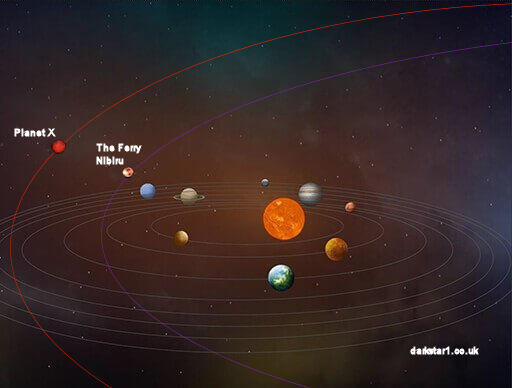
Let's instead consider the L1 LaGrange point. I calculate would be about 30AU closer to the Sun if Marduk's semi-major axis is ~500AU, and perhaps a lot more if we extend Marduk's orbit out to the 1000s of AU at aphelion. In which case Marduk's L1 (with Nibiru in it) might make it into the solar system proper during Marduk's perihelion.
Bingo.
The Retrograde Orbit
There is one other thing to bear in mind. A retrograde objects is affected far less than a prograde object. In a theoretical study on how densely packed a planetary system could become whilst retaining internal stability, astrophysicist Sean Raymond noted that planets orbiting in opposing directions have far less influence over each other that those circling in the same direction (12). This is because oppositely-orbiting objects experience comparatively fleeting encounters:
""If two planets in different orbits are going in the same direction, then they have a longer time to encounter each other as they pass, which creates a larger gravitational kick," Raymond said. "However, if they are going in the opposite direction, they zoom past each other and interact for a shorter amount of time," which means they can be closer together without colliding or scattering." (12)
Hence, Nibiru's allegedly retrograde motion brings with it distinct advantages: It is far less likely to be adversely affected by the other planets during any perihelion passage.
Written by Andy Lloyd, 18th January 2005, updated 14-17 February 2022
author of 'The Dark Star'
(2005), 'Ezekiel One'
(2009), 'The Followers of
Horus' (2010) and 'Darker Stars' (2019)
Published by Timeless Voyager Press
References:
1) Andy Lloyd "Winged Disc: The Dark Star Theory" 2001
2) Zecharia Sitchin "The 12th Planet" Avon 1976
3) Zecharia Sitchin "Genesis Revisited" Avon 1990
4) John Murray "Arguments for the presence of a distant large undiscovered Solar system planet" Monthly Notices of the Royal Astronomical Society, 309: 31-34 (1999)
academic.oup.com/mnras article
5) G. Chauvin et al. "A Giant Planet Candidate near a Young Brown Dwarf", Astronomy & Astrophysics, 425(2): L29–L32 (2004)
6) M. McKee "First direct sighting of an extrasolar planet", 11 Jan 2005, with thanks to David Pearson and Rick (article on longer available online)
7) Giorgio de Santillana & Hertha von Dechend “Hamlet’s Mill: An Essay Investigating the Origins of Human Knowledge And Its Transmission Through Myth” App. 39, pp430-451
8) 'Hill sphere'
9) "How do Lagrange Points Work?" 4 September 2021
10) Chadwick Trujillo & Scott Sheppard "A Sedna-like body with a perihelion of 80 astronomical units" Nature, 507: 471–474, 27 March 2014
11) Konstantin Batygin & Michael Brown "Evidence for a Distant Giant Planet in the Solar System" The Astronomical Journal, 151: 2, 20 January 2016,
12) Harry Baker "What's the maximum number of planets that could orbit the sun?" 12 February 2022, with thanks to Sean Raymond